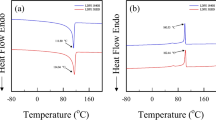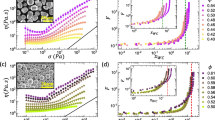Summary
The viscoelastic properties of a series of graft copolymers of poly(methyl acrylate) with styrene differing in the degree of grafting and, consequently, in the heterogeneous structure, were investigated in terms of the relaxation modulus function in a range from glassy to rubber flow consistencies.
The relaxation behavior of the corresponding homopolymers was first analyzed in terms of the four different relaxation mechanisms; localized relaxation mechanism associated with the secondary glass transition, two types of intra-molecular relaxation mechanisms due to cooperative thermal diffusion of chain segments in short and long ranges, respectively, both associated with the primary glass-rubber transition, and inter-molecular relaxation mechanisms due to also the cooperative thermal diffusion of chain segments but in further long range including the so-called chain entanglements.
The relaxation behavior of the heterogeneous system of the graft copolymers was then analyzed on the bases of the homogeneous strain hypothesis for the system as well as of the four different relaxation mechanisms for both of the two components. Two types of additional relaxation mechanisms associated with the grain boundary phenomena and with the flow of entire graft copolymer chains after melting (disintegration) of the domain structures, respectively, were investigated as characteristics of the system.
Zusammenfassung
Die viskoelastischen Eigenschaften einer Reihe von Pfropf-Kopolymeren von Polymethylacrylat mit Styrol, die sich im Grad der Pfropfung und damit folgerichtig in der heterogenen Struktur unterscheiden, wurden mit der mechanischen Relaxation im Bereich von Glas-bis zum Gummi-Verhalten untersucht.
Das Relaxationsverhalten der entsprechenden Homopolymeren war zuvor in Form von 4 verschiedenen Relaxationsmechanismen festgelegt worden; lokalisierte Relaxation verknüpft mit dem sek. Glasübergang, zwei Arten von intramolekularer Relaxation entsprechend kooperativer thermischer Diffusion von Kettensegmenten im Kurz- und Langbereich, beide verknüpft mit dem prim. Glas-Gummi-Übergang und zwischen-molekularer Relaxation, ebenfalls aufgrund kooperativer thermischer Bewegung von Kettensegmenten, aber über weite Bereiche einschl. der sog. Kettenverhakungen.
Das Relaxationsverhalten des heterogenen Systems der Pfropf-Kopolymeren wurde auf Grundlage einer homogenen Spannung sowohl für das System als für die 4 verschiedenen Relaxationsmechanismen der bei-den Komponenten analysiert.
Es traten zwei Typen von zusätzlichen Relaxations-mechanismen auf, die mit Grenzflächenphänomenen und mit dem Fließen ganzer Pfropfketten (Abbau) in Domänen-Strukturen zusammenhängen, sie wurden als charakteristisch für das System betrachtet.
Similar content being viewed by others
References
Buchdahl, R. andL. E. Nielsen, J. Polymer Sci.15, 1 (1955).
Jenkel, E. andH. U. Herwig, Kolloid-Z.148, 57 (1956).
Tobolsky, A. V., Properties and Structure of Polymers, pp. 78–83 (New York 1960).
Ferry, J. D., Viscoelastic Properties of Polymers, pp. 270–275 (New York 1961).
Nielsen, L. E., Mechanical Properties of Polymers, pp. 172–177 (New York 1963).
Takayanagi, M., H. Harima, andY. Iwata, Mem. Fac. Eng. Kyushu Univ.23, 1 (1963).
Fujino, K., Y. Ogawa, andH. Kawai, J. Appl. Polymer Sci.8, 2147 (1964).
Horino, T., Y. Ogawa, T. Soen, andH. Kawai, J. Appl. Polymer Sci.9, 2261 (1965).
Manabe, S., S. Uemura, andM. Takayanagi, Kogyo Kagaku Zasshi70, 525, 529 (1967).
Kato, K., Polymer Eng. Sci.7, 38 (1967).
Hendus, H., K.-H. Illers, andE. Ropte, Kolloid-Z. u. Z. Polymere216–217, 110 (1967).
Inoue, T., T. Soen, H. Kawai, M. Fukatsu, andM. Kurata, J. Polymer Sci., Part B,6, 75 (1968).
Matsuo, M., S. Sagae, andH. Asai, Polymer (London)10, 79 (1969).
Bradford, E. B. andE. Vanzo, J. Polymer Sci. A-1,6, 1661 (1968).
Skoulios, A. E., G. Tsoulage, andE. Fanta, J. Polymer Sci. Part C,4, 507 (1963).
Angelo, R. J., R. M. Ikeda, andM. L. Wallach, Polymer (London)6, 141 (1965).
Bohn, L., Kolloid-Z. u. Z. Polymere213, 55 (1966).
Soen, T., T. Horino, Y. Ogawa, andH. Kawai, J. Appl. Polymer Sci.10, 1499 (1966).
Cooper, S. L. andA. V. Tobolsky, J. Appl. Polymer Sci.10, 1837 (1966);11, 1361 (1967).
Childers, C. W. andG. Kraus, Rubber Chem. Technol.40, 1183 (1967).
Beecher, J. F., L. Marker, R. D. Bradford, andS. L. Aggarwal, ACS Polymer Preprints8, 1532 (1967).
Nishioka, M., Ph. D. thesis presented to the Faculty of Engineering, Kyoto University, 1972.
Kawamata, M. andY. Inoue, Kogyo Kagaku Zasshi63, 1831 (1960).
Ono, T., H. Minamiguchi, T. Soen, andH. Kawai, Kolloid-Z. u. Z. Polymere250, 394 (1972).
Nakatani, M., K. Iijima, A. Suganuma, andH. Kawai, J. Macromol. Sci. Phys.B2, 55 (1968).
Uchida, T., T. Soen, T. Inoue, andH. Kawai, J. Polymer Sci. A-2,10, 101 (1972).
Tobolsky, A. V., B. A. Dunell, andR. D. Andrews, Text. Res. J.31, 404 (1951).
Ferry, J. D., L. D. Grandine Jr., andE. R. Fitzgerald, J. Appl. Phys.24, 911 (1953).
Philippoff, W., J. Appl. Phys.24, 685 (1953).
Marvin, R. S., Proc. 2nd Intern. Cong. Rheol. pp. 156 (London 1953).
Catsiff, E. andA. N. Tobolsky, J. Colloid Sci.10, 375 (1955).
Tobolsky, A. N., J. Appl. Phys.27, 673 (1956).
Schwarzl, F. andA. J. Staverman, J. Appl. Phys.23, 838 (1952).
Williams, M. L., R. F. Landel, andJ. D. Ferry, J. Amer. Chem. Soc.77, 3701 (1955).
Sato, K., H. Nakane, T. Hideshima, andS. Iwayanagi, J. Phys. Soc. Japan9, 413 (1954).
Ferry, J. D., W. C. Child, Jr.,R. Zand, D. M. Stern, M. L. Williams, andR. F. Landel, J. Colloid Sci.12, 53 (1957).
Child, W. C., Jr. andJ. D. Ferry, J. Colloid Sci.12, 327, 389 (1957).
Fujimoto, T., Department of Synthetic Chemistry, Nagoya University, Nagoya, Japan, private communication.
Ferry, J. D. andM. L. Williams, J. Colloid Sci.7, 347 (1952);M. L. Williams andJ. D. Ferry, J. Polymer Sci.11, 169 (1953).
Saito, N., K. Okano, S. Iwayanagi, andT. Hideshima, In:H. Ehrenreich, F. Seitz, andD. Turnbull (eds.), Solid State Physics, Vol. 14, pp. 458 (NewYork 1963).
Nakayasu, H., H. Markovitz, andD. Plazek, Trans. Soc. Rheol.5, 261 (1961).
Takayanagi, M. andT. Matsuo, Macromol. Sci.-Phys.B1, 407 (1967).
Iwayanagi, S., paper presented at the 2nd Kyoto Seminar on Polymers, Kyoto 1968.
Tajiri, Y., Y. Fujii, M. Aida, andH. Kawai, J. Macromol. Sci.-Phys.B4, 1 (1970).
Author information
Authors and Affiliations
Additional information
Dedicated to Professor Dr.R. Hosemann on the occasion of his 60th birthday.
Rights and permissions
About this article
Cite this article
Soen, T., Ono, T., Yamashita, K. et al. Domain structure and viscoelastic properties of graft copolymer. Kolloid-Z.u.Z.Polymere 250, 459–470 (1972). https://doi.org/10.1007/BF01507513
Received:
Issue Date:
DOI: https://doi.org/10.1007/BF01507513




